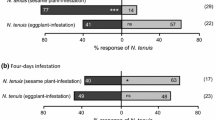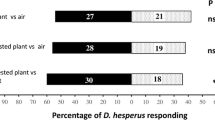Abstract
The effect of volatiles related to feeding activity of nonprey caterpillars, Spodoptera exigua, on the olfactory response of the predatory mites Phytoseiulus persimilis was examined in a Y-tube olfactometer. At a low caterpillar density (20 caterpillars on 10 Lima bean leaves), the predators were significantly more attracted to volatiles from infested leaves on which the caterpillars and their products were present or from infested leaves from which the caterpillars and their products had been removed when compared to volatiles from uninfested leaves. The predators, however, significantly avoided odors from 20 caterpillars and their products (mainly feces) removed from bean leaves. In contrast, at a higher caterpillar density (100 caterpillars on 10 Lima bean leaves), the predators avoided volatiles from caterpillar-infested bean leaves. Volatiles from infested leaves from which the caterpillars and their products had been removed were not preferred over volatiles from uninfested leaves. Volatiles from feces collected from 100 caterpillars were strongly avoided by the predators, while the behavior of the predatory mites was not affected by volatiles from 100 caterpillars removed from a plant. The data show that carnivorous arthropods may avoid nonprofitable herbivores. This avoidance seems to result from an interference of volatiles from herbivore products with the attraction to herbivore-induced plant volatiles.
Similar content being viewed by others
REFERENCES
Agelopoulos, N. G., and Keller, M. A. 1994. Plant-natural enemy association in the tritrophic system, Cotesia rubecula-Pieris rapae-Brassicaceae (Cruciferae): I. Sources of infochemicals. J. Chem. Ecol. 20:1725-1734.
Agelopoulos, N. G., Dicke, M., and Posthumus, M. A. 1995. Role of volatile infochemicals emitted by feces of larvae in host-searching behavior of parasitoid Cotesia rubecula (Hymenoptera: Braconidae): A behavioral and chemical study. J. Chem. Ecol. 21:1789-1811.
DeMoraes, C. M., Lewis, W. J., Pare, P. W., Alborn, H. T., and Tumlinson, J. H. 1998. Herbivore-infested plants selectively attract parasitoids. Nature 393:570-573.
Dicke, M. 1994. Local and systemic production of volatile herbivore-induced terpenoids: Their role in plant-carnivore mutualism. J. Plant. Physiol. 143:465-472.
Dicke, M. 1999. Are herbivore-induced plant volatiles reliable indicators of herbivore identity to foraging carnivorous arthropods? Entomol. Exp. Appl. In press.
Dicke, M., and Groeneveld, A. 1986. Hierarchical structure in kairomone preference of the predatory mite Amblyseius potentillae: Dietary component indispensable for diapuse induction affects prey location behavior. Ecol. Entomol. 11:131-138.
Dicke, M., van Beek, T. A., Posthumus, M. A., Ben Dom, N., Bokhoven, H. Van, and de Groot, Æ. 1990. Isolation and identification of volatile kairomone that affects acarine predator-prey interaction: Involvement of host plant in its production. J. Chem. Ecol. 16:381-396.
Dicke, M., Baarlen, P. van, Wessels, R., and Dukman, H. 1993. Herbivory induces systemic production of plant volatiles that attract predators of the herbivore: Extraction of endogenous elicitor. J. Chem. Ecol. 19:581-599.
Dicke, M., Takabayashi, J., Posthumus, M. A., SchÜtte, C., and Krips, O. E. 1998. Plant-phytoseiid interactions mediated by herbivore-induced plant volatiles: Variation in production of cues and in responses of predatory mites. Exp. Appl. Acarol. 22:311-333.
Geervliet, J. B. F., Vet, L. E. M., and Dicke, M. 1994. Volatiles from damaged plants as major cues in long-range host-searching by the specialist parasitoid Cotesia rubecula. Entomol. Exp. Appl. 73:289-297.
Geervliet, J. B. F., Vet, L. E. M., and Dicke, M. 1996. Innate responses of the parasitoids (Cotesia glomerata and C. rubecula (Hymenoptera: Braconidae) to volatiles from different plant-herbivore complexes. J. Insect Behav. 9:525-538.
Geervliet, J. B. F., Posthumus, M. A., Vet, L. E. M., and Dicke, M. 1997. Comparative analysis of headspace volatiles from different caterpillar-infested and uninfested food plants of Pieris species. J. Chem. Ecol. 23:2935-2954.
Geervliet, J. B. F., Vreugdenhil, A. I., Vet, L. E. M., and Dicke, M. 1998. Learning to discriminate between infochemicals from different plant-host complexes by the parasitoids Cotesia glomerata and C. rubecula (Hymenoptera: Braconidae). Entomol. Exp. Appl. 86:241-252.
Janssen, A., Bruin, J., Jacobs, G., Schraag, R., and Sabelis, M. W. 1997. Predators use volatiles to avoid prey patches with conspecifics. J. Anim. Ecol. 66:223-232.
Powell, W., Pennacchio, F., Poppy, G. M., and Tremblay, E., 1998. Strategies involved in the location of hosts by the parasitoid Aphidius ervi Haliday (Hymenoptera: Braconidae: Aphidiinae). Biol. Control 11:104-112.
RÖse, U. S. R., Alborn, H. T., Makranczy, G., Lewis, W. J., and Tumlinson, J. H. 1997. Host recognition by the specialist endoparasitoid Microplitis croceipes (Hymenoptera, Braconidae): Role of host and plant related volatiles. J. Insect Behav. 10:313-330.
Sabelis, M. W., and Van de Baan, H. E. 1983. Location of distant spider mite colonies by phytoseiid predators: Demonstration of specific kairomones emitted by Tetranychus urticae and Panonychus ulmi. Entomol. Exp. Appl. 33:303-314.
Sabelis, M. W., Afman, B. P., and Slim, P. J. 1984. Location of distant spider mite colonies by Phytoseiulus persimilis: Localization and extraction of a kairomone. Acarology 6(1):431-440.
Smith, B. H. 1993. Merging mechanism and adaptation: An ethological approach to learning and generalization, pp. 126-157, in D. R. Papaj and A. C. Lewis (eds.). Insect Learning. Chapman and Hall, New York.
Smits, P. H. 1987. Nuclear polyhedrosis virus as biological agent of Spodoptera exigua. PhD thesis. Wageningen Agricultural University, Wageningen, The Netherlands.
Steinberg, S., Dicke, M., and Vet, L. E. M. 1993. Relative importance of infochemicals from first and second trophic level in long-range host location by the larval parasitoid Cotesia glomerata. J. Chem. Ecol. 19:47-59.
Takabayashi, J., and Dicke, M. 1992. Response of predatory mites with different rearing histories to volatiles of uninfested plants. Entomol. Exp. Appl. 64:187-193.
Takabayashi, J., and Dicke, M. 1996. Plant-carnivore mutualism through herbivore-induced carnivore attractants. Trends Plant Sci. 1:109-113.
Takabayashi, J., Dicke, M., and Posthumus, M. A. 1991. Variation in composition of predator-attracting allelochemicals emitted by herbivore-infested plants: Relative influence of plant and herbivore. Chemoecology 2:1-6.
Takabayashi, J., Dicke, M., and Posthumus, M. A. 1994. Volatile herbivore-induced terpenoids in plant-mite interactions: Variation caused by biotic and abiotic factors. J. Chem. Ecol. 20:1329-1354.
Takabayashi, J., Takahashi, S., Dicke, M., and Posthumus, M. A. 1995. Developmental stage of herbivore Pseudaletia separata affects production of herbivore-induced synomone by corn plants. J. Chem. Ecol. 21:273-287.
Turlings, T. C. J., Tumlinson, J. H., and Lewis, W. J. 1990. Exploitation of herbivore-induced plant odors by host-seeking parasitic wasps. Science 250:1251-1253.
Turlings, T. C. J., Tumlinson, J. H., Eller, F. J., and Lewis, W. J. 1991a. Larval-damaged plants: Source of volatile synomones that guide the parasitoid Cotesia marginiventris to the microhabitat of its hosts. Entomol. Exp. Appl. 58:75-82.
Turlings, T. C. J., Tumlinson, J. H., Heath, R. R., Proveaux, A. T., and Doolittle, R. E. 1991b. Isolation and identification of allelochemicals that attract the larval parasitoid, Cotesia marginiventris (Cresson), to the microhabitat of one of its hosts. J. Chem. Ecol. 17:2235-2251.
Turlings, T. C., WÄckers, F. L., Vet, L. E. M., Lewis, W. J., and Tumlinson, J. H. 1993a. Learning of host-finding cues by hymenopterous parasitoids, pp. 51-78, in D. R. Papaj and A. C. Lewis (eds.). Insect Learning. Chapman and Hall, New York.
Turlings, T. C. J., McCall, P., Alborn, H. T., and Tumlinson, J. H. 1993b. An elicitor in caterpillar oral secretions that induces corn seedlings to emit chemical signals attractive to parasitic wasps. J. Chem. Ecol. 19:411-425.
Turlings, T. C. J., Loughrin, J. H., McCall, P. J., Rose, U. S. R., Lewis, W. J., and Tumlinson, J. H. 1995. How caterpillar-damaged plants protect themselves by attracting parasitic wasps. Proc. Natl. Acad. Sci. U.S.A. 92:4169-4174.
Vet, L. E. M., Jong, A. G. de, Franchi, E., and Papaj, D. R. 1998. The effect of complete versus incomplete information on odour discrimination in a parasitic wasp. Anim. Behav. 55:1271-1279.
Author information
Authors and Affiliations
Rights and permissions
About this article
Cite this article
Shimoda, T., Dicke, M. Volatile Stimuli Related to Feeding Activity of Nonprey Caterpillars, Spodoptera exigua, Affect Olfactory Response of the Predatory Mite Phytoseiulus persimilis . J Chem Ecol 25, 1585–1595 (1999). https://doi.org/10.1023/A:1020888816525
Issue Date:
DOI: https://doi.org/10.1023/A:1020888816525




